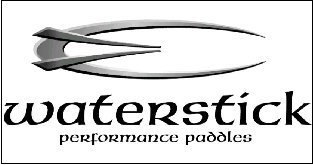WATERSTICK
PADDLES

In the
watersports industry, every company has a hook. Some
companies tout indestructible paddles, others promote
the extreme lightweight and springiness of their
products. Some hooks even claim revolutions in design
so advantageous, you would be crazy not to paddle with
their “stick”. One Canadian company has taken
advances in paddle technology to a whole new level and
has delivered on their hook.
Waterstick(www.waterstick.com)
manufactures paddles for a variety of uses (touring,
whitewater and rafting). They are a subsidiary of
Baycomp, a company that manufactures thermoplastic
supplies for industrial, medical and aeronautical
fields. All the materials are generated in-house,
giving the company exclusive quality control measures.
Waterstick utilizes Baycomp’s experience in these
fields in both the design and materials departments to
create paddles that stand out from the competition.
Waterstick has two
different styles of paddle for each sport: the Karma
series incorporates fiberglass into the paddle
blades, making these paddles a bit more forgiving than
their cousin, the Zen series. Zen series
paddles are full-on carbon fiber construction, making
them stiffer, stronger and bit less forgiving. Both
material types have their advantages: fiberglass
flexes a little, providing those with sensitive joints
a paddle that is less stressful on the body and a
chance the feel the water a little better. Carbon
fiber is lighter, stronger and stiffer, thereby
allowing a much more efficient transfer of power to
move the boat.
The carbon fiber
utilized in their Zen series is an exclusive material
called Fiber Reinforced Thermoplastic (FTP). FTP, in
short, is a composite cloth with an advanced
thermoplastic resin matrix that, when molded, is
visually identical to standard wet lay-up products,
but without the associated brittleness. This material
is stronger in impact strength, overall tensile
strength and abrasion resistance than standard
fiberglass or other carbon fiber-based paddles.
Waterstick also states that the production of an FTP
paddle releases no toxic gasses into the environment,
and the material is 100% recyclable.
Waterstick
paddles also have a unique surface profile that
divides the blade into three sections across the
power-face (tri-hedral design, visible as a unique Y
shaped ridge extending out from the center axis of the
blade), as opposed to other paddles where there is a
semi-flat powerface or a two-section powerface (the
standard di-hedral design, characterized by a ridge in
the paddle face that coincides with the spine and
shaft). The difference between Trihedral and Dihedral
can be felt during your forward strokes. Dihedral or
semi-flat blades have a tendency to “flutter” back
and forth while pulling on the paddle. This flutter is
generated by the uneven surface flow of water off the
end of the blade. Trihedral blades significantly
reduce the occurance of flutter by allowing a more
even distribution of water off the end of the blade,
thereby making it more stable. The trihedral profile
also acts like a built-in skeleton, transferring
stress across the blade surface in an even
distribution, making the blade stronger while
remaining light in weight and very stiff.
Their shaft is
what they describe as “ovalized” – generally
meaning rounded. However, there is no indexing, so
losing one’s grip on the shaft while surfing a hole
could make your roll attempts interesting. The paddle
also has a low “swing weight”, meaning that
because the blades are so light, it is easier to get
them around when paddling quickly. And it takes less
energy to paddle, giving one more energy to play and
to execute technical moves.
I am a 155-pound,
5’4” female paddler that has been boating
whitewater (Class 3-4 water) for 5 years. I have owned
a total of 4 different paddles in my career, ranging
from the basic Harmony Rapid Passage to a Seven2
I-series. I now paddle with a Waterstick Zen
Straight Shaft, 188 cm, 12-degree feather,
Right-Hand-Control (RHC) paddle. These dimensions
may sound small for a paddle, but for whitewater
playboating and someone my size, they are just right.
In the year and
half of paddling I have done with this paddle
(approximately 105 days on the water), my Zen remains
structurally sound and still performs as good as the
first day I used it. There are the obvious collection
of scratches and dings that go along with paddling
shallow whitewater rivers, however, overall the paddle
has done well to withstand the abuse (it has even been
employed in the occasional game of pepper at takeout
while awaiting shuttle – this I do not recommend).
If you are looking
for a great paddle and willing to pay a little more, I
highly recommend Waterstick paddles. They are light,
strong and durable and well worth the investment. And
should any troubles come up, I have found their
customer service reps friendly and knowledgeable. But
be warned – factory service will require you to part
with your stick for a while! They’re in Canada.
For more
information on Waterstick paddles visit www.waterstick.com
By:
Kimberly Degutis